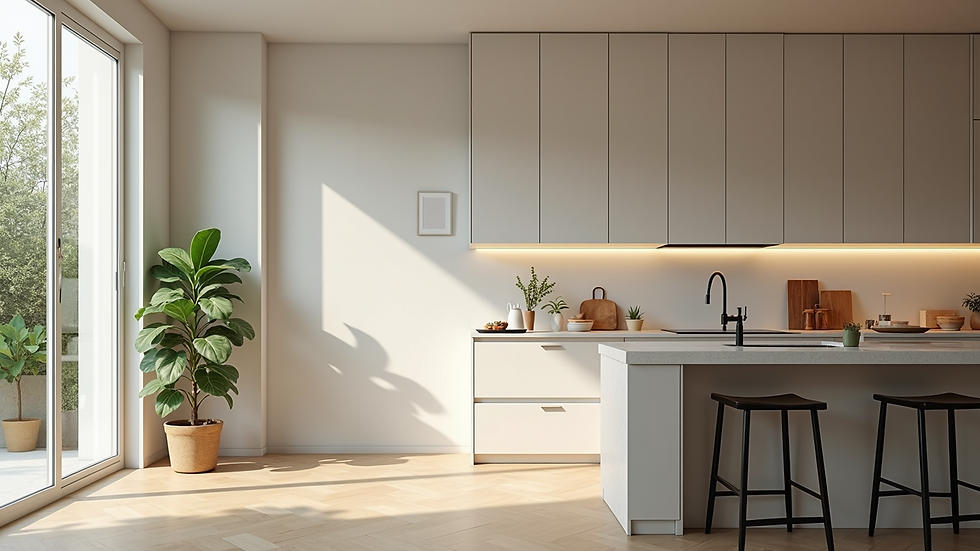Revolutionizing Interiors with 3D Rendering
- Mgfx india
- Oct 12
- 4 min read
Imagine stepping into a space that feels tailor-made just for you, where every detail pops with vibrant clarity and every corner tells a story. That’s the magic of 3D interior visuals! This technology is transforming how property developers, real estate marketers, and architects showcase their projects. It’s no longer about static blueprints or flat images - it’s about immersive, dynamic experiences that captivate and convince clients instantly. Ready to dive into this exciting world? Let’s explore how 3D rendering is revolutionizing interiors and why it’s a game-changer for your projects!

The Power of 3D Interior Visuals in Modern Design
3D interior visuals bring designs to life like never before! Instead of imagining how a room might look, you get to see it in stunning detail. This technology allows you to visualize textures, colors, lighting, and spatial arrangements with breathtaking realism. It’s like having a virtual walkthrough before a single brick is laid.
Why is this so powerful? Because it helps you:
Communicate ideas clearly: Clients and stakeholders instantly understand the vision.
Make informed decisions: Spot design flaws or improvements early.
Save time and money: Avoid costly changes during construction.
Boost marketing appeal: Stunning visuals attract more buyers and investors.
For example, a property developer can showcase a luxury apartment with different furnishing styles, lighting moods, and even seasonal decorations. This flexibility creates a personalized experience that resonates deeply with potential buyers.

How 3D Interior Visuals Enhance Client Engagement
Engagement is everything in real estate and architecture! When clients can interact with a design, their excitement and confidence skyrocket. 3D interior visuals offer interactive elements like 360-degree views, virtual reality tours, and customizable options. This means clients can explore every nook and cranny, change colors or materials, and truly feel connected to the space.
Here’s how this boosts engagement:
Immersive Experience: Clients feel like they’re inside the property.
Customization: They can tweak designs to match their tastes.
Emotional Connection: Visualizing their future home or office creates a strong bond.
Faster Decisions: Clear visuals reduce hesitation and speed up approvals.
Architects can also use these visuals to collaborate more effectively with clients and contractors, ensuring everyone is on the same page. This reduces misunderstandings and streamlines the entire project lifecycle.
What is the cost of 3D rendering services?
You might wonder, “What’s the investment required for these stunning visuals?” The cost of 3D rendering services varies depending on several factors:
Project complexity: Larger or more detailed interiors require more time and resources.
Level of detail: Photorealistic renders with intricate textures and lighting cost more.
Turnaround time: Faster delivery often comes with a premium.
Additional features: Interactive tours or animations add to the price.
On average, a high-quality 3D interior render can range from a few hundred to several thousand dollars per image. However, the return on investment is significant. By showcasing your projects with eye-catching visuals, you attract more clients, close deals faster, and reduce costly revisions.
For those looking for reliable and professional 3d interior rendering services, partnering with experts like Magnetic GraFX ensures you get top-notch quality and tailored solutions that fit your budget and goals.

Practical Tips for Using 3D Interior Visuals Effectively
To maximize the impact of 3D interior visuals, here are some actionable recommendations:
Start early: Integrate 3D rendering in the initial design phase to explore options freely.
Focus on key spaces: Highlight living rooms, kitchens, and master bedrooms where buyers spend most time.
Use multiple angles: Provide various perspectives to give a comprehensive view.
Incorporate natural lighting: Show how sunlight interacts with the space throughout the day.
Add human elements: Subtle touches like furniture or decor create a lived-in feel.
Leverage virtual staging: Showcase furnished interiors even if the property is empty.
Combine with marketing materials: Use renders in brochures, websites, and social media for consistent branding.
By following these tips, you create a compelling narrative around your project that resonates emotionally and intellectually with your audience.
The Future of Interior Design is Here - Embrace It!
The revolution in interior design is happening right now, and 3D interior visuals are leading the charge! This technology is not just a trend - it’s a fundamental shift in how spaces are conceived, presented, and experienced. For property developers and marketers, embracing 3D rendering means standing out in a crowded market and delivering unforgettable experiences.
Imagine offering your clients the ability to walk through their future home virtually, customize finishes on the fly, and make confident decisions backed by crystal-clear visuals. That’s the future, and it’s available today!
If you want to elevate your projects and captivate your audience, don’t wait. Explore the possibilities of 3D interior visuals and partner with experts who can bring your vision to life with precision and flair.
Get ready to revolutionize interiors and watch your projects shine like never before! 🚀✨




Comments